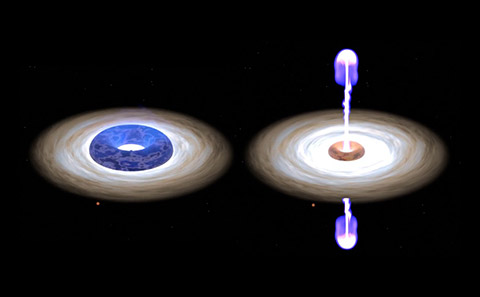
A new study has discovered that the powerful jets of wind that blast out of a black hole only occur after it has built up a hot outer layer of plasma, known as its corona. Researchers observed the behaviour of a black hole in our galaxy and developed a cosmic echocardiogram graph, showing its "heartbeat".
The team, led by the University of Groningen in the Netherlands and including the University of Southampton, have published their results in the journal Nature Astronomy.
Just as the blood in a human heart cannot be in the atrium and in ventricles at the same time, a black hole also appears to first collect material and heat it up in a so-called corona, only then to spit it out in jets.
"It sounds logical, but there has been a debate for twenty years about whether the corona and the jet were simply the same thing. Now we see that they arise one after the other and that the jet follows from the corona," says principal investigator Mariano Méndez from the University of Groningen.
"It was quite a challenge to demonstrate this sequential nature. We had to compare data of years with that of seconds, and of very high energies with very low ones," he continued.
15 years of data
The researchers collected 15 years of data from several telescopes. Amongst others, they pointed the Rossi X-ray Timing Explorer at the black hole GRS 1915+105 from space about every three days and collected high-energy X-ray radiation from the corona. The astronomers combined the X-ray data with those of the Ryle Telescope. This is a collection of radio dishes about ninety kilometres north of London, which collect low-energy radio radiation from the jet of the black hole almost every day.
"Sometimes we need years of regular observations to learn fundamental physics. This is one of those cases, where we had to combine fifteen years of data from ground-based and space-based telescopes to understand how this black hole is interacting with its environment," said co-author of the study Dr Diego Altamirano from the University of Southampton
The black hole GRS 1915+105 is not an isolated black hole, but a double system consisting of a black hole and a normal star that circle around each other. This double system lies in our Milky Way at about 36,000 light years from Earth. The black hole weighs about as much as twelve times our Sun, making it one of the heaviest known stellar black holes.
It could be happening at the centre of the Milky Way as well
Now that the researchers have proven the sequence, there are still some unanswered questions. For example, the X-ray radiation that the telescopes collect from the corona contains more energy than can be explained by the temperature of the corona alone. The researchers suspect that a magnetic field coming from the accretion disk provides extra energy. This magnetic field and the accompanying energy could also explain why jets are formed. If the magnetic field acts in chaotic manner, the corona heats up. If the magnetic field then becomes more organised, material can escape via the field lines into a jet.
The researchers suggest that the principle they demonstrated may also apply to heavier black holes, for example to the supermassive black hole at the centre of our Galaxy.






